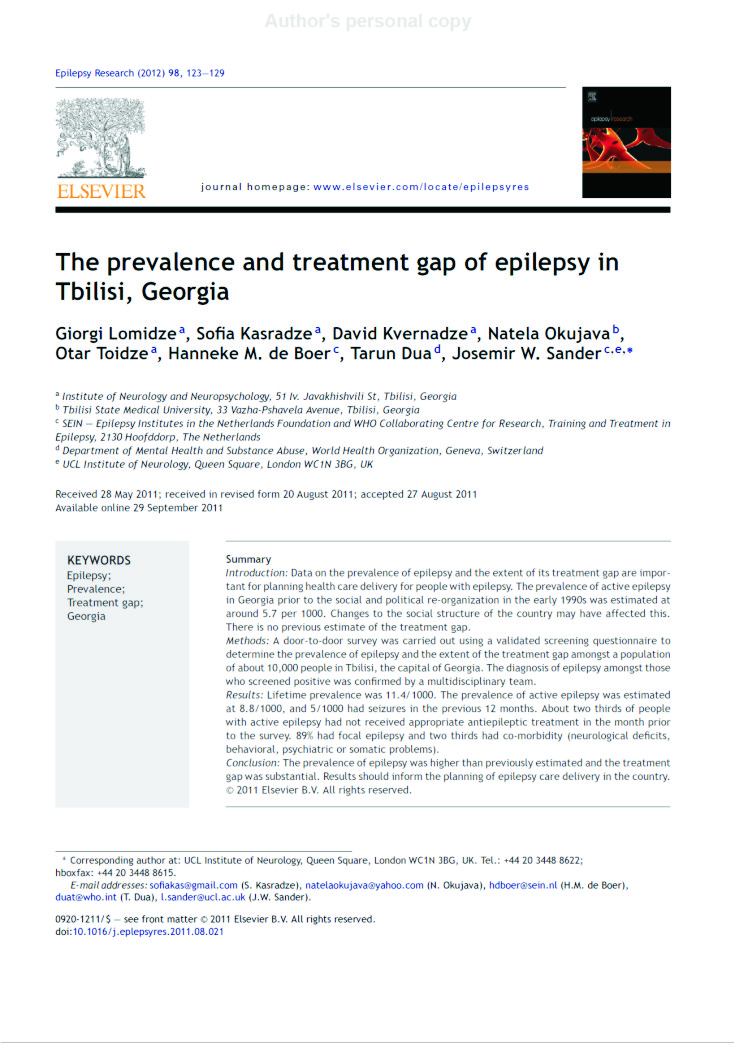The Prevalence and Treatment Gap of Epilepsy in Tbilisi, Georgia
 The Prevalence and Treatment Gap of Epilepsy in Tbilisi, Georgia
The Prevalence and Treatment Gap of Epilepsy in Tbilisi, Georgia
Giorgi Lomidzea, Sofia Kasradzea, David Kvernadzea, Natela Okujavab, Otar Toidzea, Hanneke M de Boerc, Tarun Duad and Josemir W. Sanderc,e
a Institute of Neurology and Neuropsychology, 51 Iv. Javakhishvili St, Tbilisi, Georgia
Fax: + 995 32 295 89 72 Email: sofiakas@gmail.com
b Tbilisi State Medical University, 33 Vazha-Pshavela Avenue, Tbilisi, Georgia
Fax: + 995 32 222 68 21 Email: natelaokujava@yahoo.com
c SEIN – Epilepsy Institute in the Netherlands and WHO Collaborating Centre for Research, Training and Treatment in Epilepsy, 2130 Hoofddorp, the Netherlands Fax: + 31 23 55 88 419 Email: hdboer@sein.nl
d Department of Mental Health and Substance Abuse, World Health Organization, Geneva, Switzerland Phone: + 41 22 7913059 Email: duat@who.int
e UCL Institute of Neurology, Queen Square, London WC1N 3BG, UK
Phone : + 44 20 3108 0122 ; Fax: + 44 20 3108 0115 Email: lsander@ion.ucl.ac.uk
Summary
Introduction
Data on the prevalence of epilepsy and the extent of its treatment gap are important for planning healthcare delivery for people with epilepsy. The prevalence of active epilepsy in Georgia prior to the social and political re-organization in the early 1990s was estimated at around 5.7 per 1,000. Changes to the social structure of the country may have affected this. There is no previous estimate of the treatment gap.
Methods
A door-to-door survey was carried out using a validated screening questionnaire to determine the prevalence of epilepsy and the extent of the treatment gap amongst a population of about 10,000 people in Tbilisi, the capital of Georgia. The diagnosis of epilepsy amongst those who screened positive was confirmed by a multidisciplinary team.
Results
Lifetime prevalence was 11.4/1,000. The prevalence of active epilepsy was estimated at 8.8/1,000, and 5/1,000 had seizures in the previous 12 months. About two thirds of people with active epilepsy had not received appropriate antiepileptic treatment in the month prior to the survey. 89% had focal epilepsy and two thirds had co-morbidity (neurological deficits, behavioral, psychiatric or somatic problems).
Conclusion
The prevalence of epilepsy was higher than previously estimated and the treatment gap was substantial. Results should inform the planning of epilepsy care delivery in the country.
Key words: Epilepsy, Prevalence, Treatment gap, Georgia.
